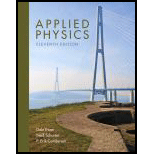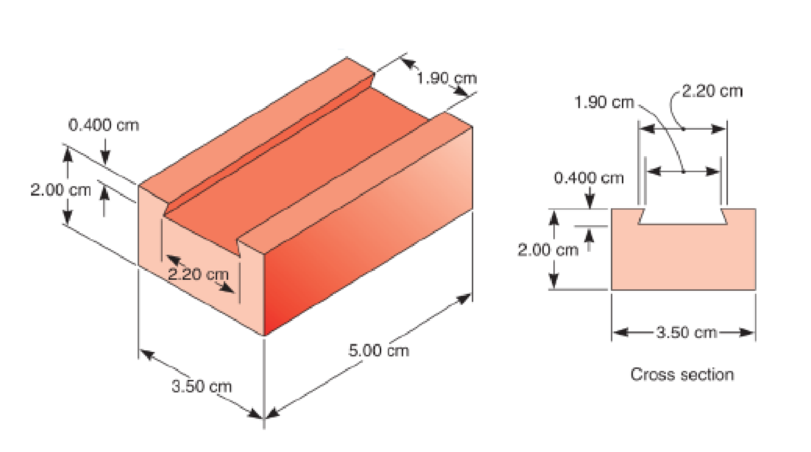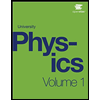
Applied Physics (11th Edition)
11th Edition
ISBN: 9780134159386
Author: Dale Ewen, Neill Schurter, Erik Gundersen
Publisher: PEARSON
expand_more
expand_more
format_list_bulleted
Concept explainers
Textbook Question
Chapter 2.3, Problem 26P
Find the cross-sectional area of the dovetail slide show in Fig. 2.9.
Figure 2.9

Expert Solution & Answer
Want to see the full answer?
Check out a sample textbook solution
Students have asked these similar questions
A weight lifter can bench press 171 kg. how many miligrams (mg) is this?
Consider that in one mile there are 5280 feet ,:a car is moving at 60mi/h, what is thein ft/s
The volume of a rectangular wooden crate is 141 m3. It’s length is 7.66 meters & width is 3.75 meters. What is its height?
Chapter 2 Solutions
Applied Physics (11th Edition)
Ch. 2.1 - =stforSCh. 2.1 - a=tforVCh. 2.1 - w = mg for mCh. 2.1 - F = ma for aCh. 2.1 - E = IR for RCh. 2.1 - V = lwh for wCh. 2.1 - Ep = mgh for gCh. 2.1 - Ep = mgh for hCh. 2.1 - 2 = 2gh for hCh. 2.1 - XL = 2 f L for f
Ch. 2.1 - P=WtforWCh. 2.1 - p=FAforFCh. 2.1 - P=WtforiCh. 2.1 - p=FAforACh. 2.1 - Ek=12m2formCh. 2.1 - Ek=12m2Ch. 2.1 - W = Fs for SCh. 2.1 - f = i + at for aCh. 2.1 - V = E Ir for lCh. 2.1 - 2 = 1 + at for tCh. 2.1 - R=2PforPCh. 2.1 - R=kLd2forLCh. 2.1 - Prob. 23PCh. 2.1 - XC=12fCforfCh. 2.1 - R=LAforLCh. 2.1 - RT = R1 + R2 + R3 + R4 for R3Ch. 2.1 - Q1 = P(Q2 Q1) for Q2Ch. 2.1 - ISIP=NPNSforIPCh. 2.1 - VPVS=NPNSforNSCh. 2.1 - Prob. 31PCh. 2.1 - Prob. 32PCh. 2.1 - Prob. 33PCh. 2.1 - Ft=m(V2V1)forV1Ch. 2.1 - Q=I2RtJforRCh. 2.1 - x=xi+it+12at2forX1Ch. 2.1 - A = r2 for r, Where r is a radiusCh. 2.1 - V = r2h for r, Where r is a radiusCh. 2.1 - R=kLd2 for d, where d is a diameterCh. 2.1 - V=13r2h for r, where r is a radiusCh. 2.1 - Solve each formula for the quantity given. 41....Ch. 2.1 - Solve each formula for the quantity given. 42....Ch. 2.2 - For each formula, (a) solve for the indicated...Ch. 2.2 - For each formula, (a) solve for the indicated...Ch. 2.2 - For each formula, (a) solve for the indicated...Ch. 2.2 - For each formula, (a) solve for the indicated...Ch. 2.2 - For each formula, (a) solve for the indicated...Ch. 2.2 - For each formula, (a) solve for the indicated...Ch. 2.2 - For each formula, (a) solve for the indicated...Ch. 2.2 - For each formula, (a) solve for the indicated...Ch. 2.2 - For each formula, (a) solve for the indicated...Ch. 2.2 - For each formula, (a) solve for the indicated...Ch. 2.2 - For each formula, (a) solve for the indicated...Ch. 2.2 - For each formula, (a) solve for the indicated...Ch. 2.2 - For each formula, (a) solve for the indicated...Ch. 2.2 - For each formula, (a) solve for the indicated...Ch. 2.2 - For each formula, (a) solve for the indicated...Ch. 2.2 - For each formula, (a) solve for the indicated...Ch. 2.2 - For each formula, (a) solve for the indicated...Ch. 2.2 - For each formula, (a) solve for the indicated...Ch. 2.2 - For each formula, (a) solve for the indicated...Ch. 2.2 - For each formula, (a) solve for the indicated...Ch. 2.3 - Find the volume of the box in Fig. 2.3. Figure 2.3Ch. 2.3 - Find the volume of a cylinder whose height is 7.50...Ch. 2.3 - Find the volume of a cone whose height is 9.30 cm...Ch. 2.3 - Find the volume of the cylinder. Figure 2.6Ch. 2.3 - Find the cross-sectional area of the cylinder....Ch. 2.3 - Find the lateral surface area of the cylinder....Ch. 2.3 - Find the total volume of the building shown in...Ch. 2.3 - Find the cross-sectional area of the concrete...Ch. 2.3 - Find the volume of a rectangular storage facility...Ch. 2.3 - Find the cross-sectional area of a piston head...Ch. 2.3 - Find the area of a right triangle that has legs of...Ch. 2.3 - Find the length of the hypotenuse of the right...Ch. 2.3 - Find the cross-sectional area of a pipe with outer...Ch. 2.3 - Find the volume of a spherical water tank with...Ch. 2.3 - The area of a rectangular parking lot is 900m2. If...Ch. 2.3 - The volume of a rectangular crate is 192 ft3. If...Ch. 2.3 - Find the volume of a brake cylinder whose diameter...Ch. 2.3 - Find the volume of a tractor engine cylinder whose...Ch. 2.3 - A cylindrical silo has a circumference of 29.5 m....Ch. 2.3 - If the silo in Problem 19 has a capacity of...Ch. 2.3 - A wheel 30.0 cm in diameter moving along level...Ch. 2.3 - The side of the silo in Problems 19 and 20 needs...Ch. 2.3 - You are asked to design a cylindrical water tank...Ch. 2.3 - If the height of the water tank in Problem 23 were...Ch. 2.3 - A ceiling is 12.0 ft by 15.0 ft. How many...Ch. 2.3 - Find the cross-sectional area of the dovetail...Ch. 2.3 - Find tile volume of the storage bin shown in Fig....Ch. 2.3 - The maximum cross-sectional area of a spherical...Ch. 2.3 - How many cubic yards of concrete are needed to...Ch. 2.3 - What length of sidewalk 4.00 in. thick and 4.00 ft...Ch. 2.3 - Find the volume of each figure.Ch. 2.3 - Inside diameter: 20.0 cm Outside diameter: 50.0 cmCh. 2 - A formula is a. the amount of each value needed....Ch. 2 - Subscripts are a. the same as exponents. b. used...Ch. 2 - A working equation a. is derived from the basic...Ch. 2 - Cite two examples in industry in which formulas...Ch. 2 - How are subscripts used in measurement?Ch. 2 - Why is reading the problem carefully the most...Ch. 2 - How can making a sketch help in problem solving?Ch. 2 - What do we call the relationship between data that...Ch. 2 - How is a working equation different from a basic...Ch. 2 - How can analysis of the units in a problem assist...Ch. 2 - How can making an estimate of your answer assist...Ch. 2 - Solve F = ma for (a) m and (b) a.Ch. 2 - Solve =2ghforh.Ch. 2 - Solve s=12(f+i)tforf.Ch. 2 - Prob. 4RPCh. 2 - Given P = a + b + c, with P = 36 ft, a = 12 ft,...Ch. 2 - Given A=(a+b2)h, with A=210m2, b = 16.0 m, and h =...Ch. 2 - Given A = r2, if A. = 15.0 m2, find r.Ch. 2 - Given A=12bh, if b = 12.2 cm and h = 20.0 cm, what...Ch. 2 - A cone has a volume of 314 cm3 and radius of 5.00...Ch. 2 - A right triangle has a side of 41.2 mm and a side...Ch. 2 - Given a cylinder with a radius of 7 .20 cm and a...Ch. 2 - A rectangle has a perimeter of 40.0 cm. One side...Ch. 2 - The formula for the volume of a cylinder is V =...Ch. 2 - The formula for the area of a triangle is A=12bh....Ch. 2 - Find the volume of the lead sleeve with the cored...Ch. 2 - A rectangular plot of land measure 40.0 m by...Ch. 2 - You run a landscaping business and know that you...Ch. 2 - A room that measures 10.0 ft wide, 32.0 ft long,...Ch. 2 - Instead of using a solid iron beam, structural...Ch. 2 - A shipping specialist at a craft store needs to...Ch. 2 - A crane needs to lift a spool of fine steel cable...
Knowledge Booster
Learn more about
Need a deep-dive on the concept behind this application? Look no further. Learn more about this topic, physics and related others by exploring similar questions and additional content below.Similar questions
arrow_back_ios
arrow_forward_ios
Recommended textbooks for you
 An Introduction to Physical SciencePhysicsISBN:9781305079137Author:James Shipman, Jerry D. Wilson, Charles A. Higgins, Omar TorresPublisher:Cengage Learning
An Introduction to Physical SciencePhysicsISBN:9781305079137Author:James Shipman, Jerry D. Wilson, Charles A. Higgins, Omar TorresPublisher:Cengage Learning University Physics Volume 1PhysicsISBN:9781938168277Author:William Moebs, Samuel J. Ling, Jeff SannyPublisher:OpenStax - Rice University
University Physics Volume 1PhysicsISBN:9781938168277Author:William Moebs, Samuel J. Ling, Jeff SannyPublisher:OpenStax - Rice University

An Introduction to Physical Science
Physics
ISBN:9781305079137
Author:James Shipman, Jerry D. Wilson, Charles A. Higgins, Omar Torres
Publisher:Cengage Learning

University Physics Volume 1
Physics
ISBN:9781938168277
Author:William Moebs, Samuel J. Ling, Jeff Sanny
Publisher:OpenStax - Rice University
Math Antics - Scientific Notation; Author: mathantics;https://www.youtube.com/watch?v=bXkewQ7WEdI;License: Standard YouTube License, CC-BY
Physics CH 0: General Introduction (14 of 20) How to Estimate Number of Teachers in US; Author: Michel van Biezen;https://www.youtube.com/watch?v=GBv_JLUzM-M;License: Standard Youtube License